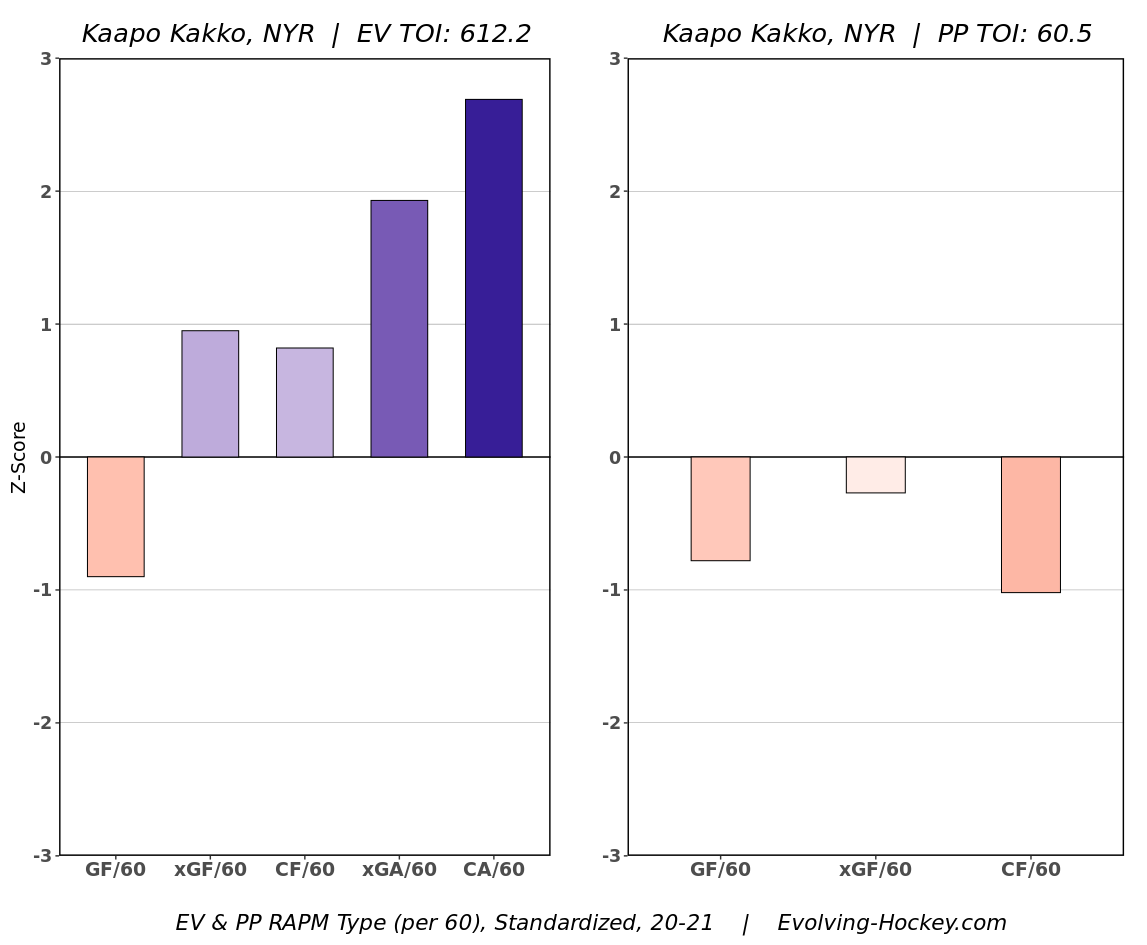
If there is one consistent thing about passionate Rangers fans, it’s that every prospect is a bust if they don’t do what Adam Fox did. Igor Shesterkin was injury prone and should have been traded after the bubble, remember? But when it comes to Kaapo Kakko, there seems to be a loud contingent of fans that thinks he’s a bust. He has certainly underwhelmed, and there is no ignoring that. But should you be worried about Kaapo Kakko?
Short answer – No
The short answer here is no, you should not be worried about Kaapo Kakko. On paper, this is his third season, but you need to add nuance. His first season he should have been in the AHL, and that was a miss by the Rangers. It’s something we will talk about later on. He certainly had a bad rookie season. That season was also cut short by COVID.
His second season was a complete 180, figuring out the defensive side of things and also putting up a better offensive season. The hardest part of hockey is figuring out the defensive game, and Kakko did that. That season, if you recall, had no preseason, no training camp, and the kids were basically thrown into the fire. Oh, and he also got COVID.
This is his third season, and he, like the rest of the team, can’t score. His zero points are certainly a concern, and no one is disagreeing. But there’s more to the game than scoring, even though he is certainly expected to score as a second overall pick.
Long answer – maybe you should be worried about Kaapo Kakko?
Kakko has only played 120 games, which in theory would put him halfway through his second season. But in that time, he hasn’t really shown the offensive ability he showed in Liiga that made him the second overall pick. Part of that is powerplay time, which is a problem, but there’s more to it than just playing time.
A little under two years ago, we noted that Kakko needed to adjust how he was receiving the puck in open ice. Long story short, he was receiving the puck too close to his body. Add in the smaller ice surface, and he didn’t have the time to make quick decisions. That seems to have been rectified, but that was just one of a few things that were eye catching.
The second, and perhaps most concerning, is his skating. Some guys will never be fantastic skaters, and it looks like Kakko may be one of those guys. It is rare for players to completely overhaul their skating, Brian Boyle being the rare exception. Add Kakko’s skating to his shot, which does play into how he receives the puck, and he may not be a prolific goal scorer.
The Aleksander Barkov comparison
When drafted, Kakko was immediately likened to Aleksander Barkov. Barkov, in his first 120 games, had a line of 22-33-55. Kakko has 19-21-40. This is at all strengths. At evens, Barkov had a line of 18-29-47. Kakko was much worse, with a line of 15-9-24. Kakko had 13 PPP in his rookie season, and that is often lost in the shuffle. The Barkov comparison, though extends beyond mere points.
Kakko has spent the overwhelming majority of his NHL time thus far with Filip Chytil as his center. The next two most frequent forwards: Ryan Strome and Brett Howden. Strome has been good, but Howden is Howden. Barkov spent most of his two seasons with Brad Boyes and Jonathan Huberdeau, with Sean Bergenheim as the third. Barkov saw better teammates, and I don’t think it’s a stetch to say that.
When we compare the two over their full seasons, what jumps out to me is the GF/60 at even strength. This is largely driven by shooting, teammates, and honestly some luck. Kakko’s shooting is not at the same level as Barkov’s, which is a fair assessment. But Kakko has also not had the same teammate quality. When you factor in the skating too, you can see why the GF/60 is down.
That said, Kakko isn’t getting the luck factor when on the ice. His xGF/60, while not necessarily good, is far better than his GF/60. That leads us to believe he should start seeing more goals with him on the ice, thus leading to more points. Barkov certainly has better numbers, but Kakko has been trending up.
This is Kakko’s RAPM from last year, which shows how much of an elite defensive forward he has become. But note the xGF/60, which is well into the blue, while his actual GF/60 is in the red. Again, the luck factor plays a role. But so does the shooting piece.
He hasn’t necessarily hit the offensive numbers, so if you’re worried about Kaapo Kakko, this is valid concern.
So what does all this mean?
Conall in the BSB chat said it best. Kakko may not be a prolific goal scorer in the NHL, and he will likely sit at the 18-24 goals per year average. That’s due to his skating and shooting skill sets being below what you would have expected from a Barkov comparison.
However, Kakko does drive play, and is solid in all three zones. So Kakko’s ceiling may be that of an elite two way forward who puts up 20-30-50 a year. Is that so bad? He’s certainly on his way to reaching that too, as the harder part of the game –driving play– has mostly been figured out.
So should you be worried about Kaapo Kakko? It depends on what your expectations are. I’d certainly be concerned about some of the skill sets not progressing like we had hoped. But I wouldn’t read into raw point totals yet, especially given how out of sync the Rangers have looked. He’s just 20 years old, and has really only played 1.5 seasons in the NHL. Patience is a virtue. But so is knowing the value of your asset.
Charts from Evolving-Hockey.
Share:
More About:Players

